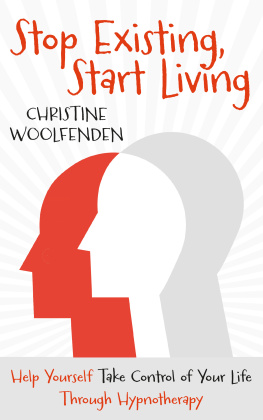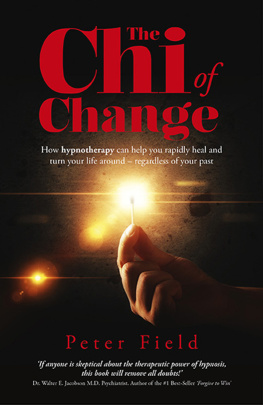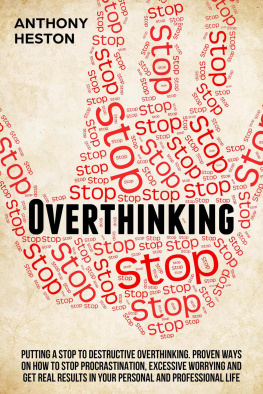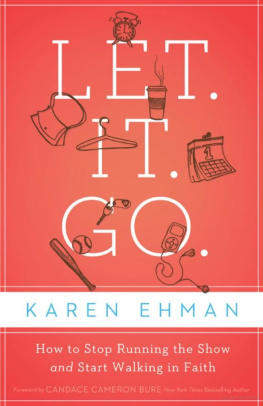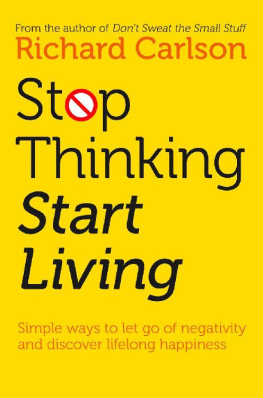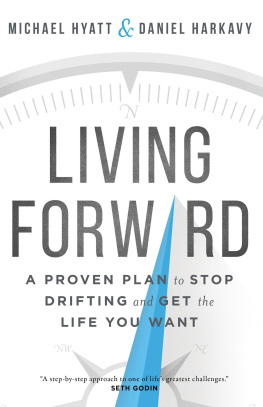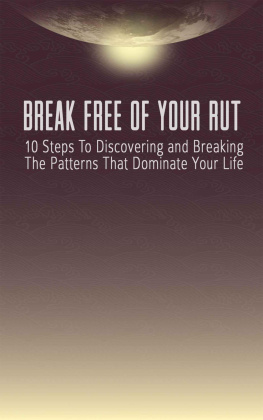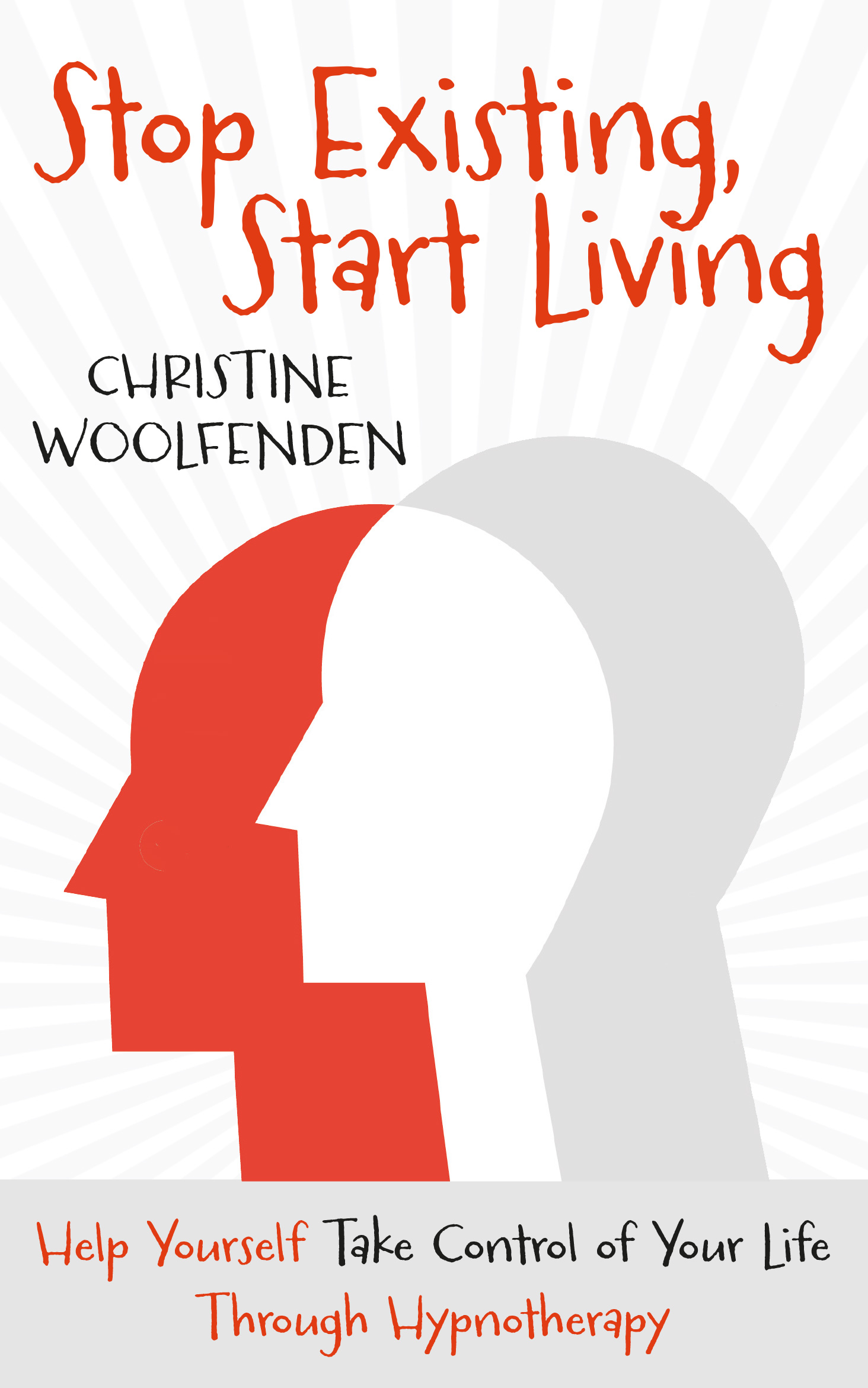Do you sometimes feel as though youre sleepwalking through life? That youre stuck in a rut? Does each step forward seem to be followed by two steps back?
Are you fed up with feeling this way, and wondering what you can do about it?
Stop Existing, Start Living is designed to help you take control of, and take responsibility for, your life, so that you can start living the life you choose to live.
The majority of what we do is driven by our unconscious mind, and follows automatic patterns of response based on our past experiences. Without realising it, we can find ourselves robotically repeating behaviours that actually make our lives worse, leaving us feeling dissatisfied, uncomfortable and ineffective, but not understanding why.
Through the relaxing and proven techniques of hypnotherapy, this book will lead you step-by-step through the process of recognising the ways in which your unconscious mind is generating your sense of discomfort and dissatisfaction. The development focus then moves to the goal of changing those old, ineffective responses, bringing to the fore thoughts, feelings and behaviours that will improve your life and your enjoyment of it.
Stop Existing, Start Living guides you through a unique and gentle process of change using ten hypnosis audio recordings. These can be downloaded at www.helpyourselfhypnotherapy.com
Christine Woolfenden DCH DHP MBPsS reg CNHC GHR SQHP is a clinical hypnotherapist committed to helping people make lasting positive change through the therapeutic application of hypnosis. She is the founder of Echelon Associates Clinical Hypnotherapy Practice in Oxfordshire.
Cover design by Judy Linard
Follow us on Twitter @dlt_books
www.dltbooks.com
First published in Great Britain in 2017 by
Darton, Longman and Todd Ltd
1 Spencer Court
140 142 Wandsworth High Street
London SW18 4JJ
2017 Christine Woolfenden
The right of Christine Woolfenden to be identified as the Author of this work has been asserted in accordance with the Copyright, Designs and Patents Act 1988
ISBN 9780232532845
A catalogue record for this book is available from the British Library
Produced by Judy Linard
Printed and bound in Great Britain by Bell & Bain, Glasgow
No responsibility for loss caused to any individual or organisation acting on or refraining from action as a result of the material in this publication can be accepted by Darton, Longman and Todd or the author.
To Charlie
Contents
List of audio cues
Acknowledgements
Where this book is concerned, there are many people to whom Im incredibly grateful. Most of all Id like to thank my trusted friends and family who believed in me sufficiently to take the time out of their busy lives to read and comment on the multiple drafts. Their constructive feedback and unending support gave me the confidence to take this project forward. Amongst these people I especially thank my husband, Charlie, my two daughters, Tess and Billie, my mother, Eleanor, my friends Sarah, Diane, Sue, Rod and Helen, my sister Liz, my nephew Joe and my cousin Loopy. And then theres John, without whose publishing expertise I would have been lost.
Id also like to thank Darton, Longman and Todd for having the vision to publish this book, and to Nicola of The Institute of Clinical Hypnosis for her thorough and stimulating hypnotherapy training.
Please consider yourselves well and truly appreciated.
To whom it may concern
Duncan sat alone at the edge of the worn single bed at his parents house, head in hand. At 41, this was the last place on earth he wanted to be. On the floor, in between the cardboard boxes that contained his possessions, was a local advertiser, the pages randomly opened. A word caught his eye. It read change. For him, it was a light-bulb event, a moment of clarity that over-powered his tolerance of the status quo, prompted action and led him to my door.
What is it, I wonder, thats led you here to these words on this page?
It could be curiosity, a desire to know more about hypnotherapy, perhaps a sense of obligation to a long-suffering friend who bought you a copy.
Or maybe, just maybe, youre fed up with robotically trudging your way through life and have had enough of merely getting by. Perhaps youre tired of those uneasy, niggling feelings of discomfort and dissatisfaction, and are wondering what the heck you can do about it.
I wholeheartedly welcome every one of you; especially those who fall within the latter category, for you stand to gain most of all.
Proviso
This book is not intended for individuals who have suffered abusive, violent or traumatic experiences, nor would I recommend people follow this process if theyve been diagnosed with a mental disorder. Instead, when you feel the time is right, I advise you to seek bespoke, face-to-face advice and support with a professional clinical hypnotherapist or a therapist from a preferred client-centred discipline.
Also, if the questions posed in each chapter of the book or the audio recordings that accompany this publication raise unbearably strong emotions, I advise you to stop and seek one-on-one professional guidance.
Preface
In 1955, the British Medical Association (BMA) issued a report stating that hypnosis was a valuable medical tool, and recommended that all new doctors be trained in applying it. Despite this endorsement, hypnosis has since become a much maligned, misrepresented and misunderstood form of psychological treatment. Because of this, hypnotherapy is often seen as the last option; Ive tried everything else and nothings worked so lets throw caution to the wind and give it a shot self-defeating. Or, its seen as something with magical properties, a method that can change our behaviour whether we want it to or not by forces that lie beyond our control and human understanding frightening and disempowering. Or its simply seen as light entertainment.
Based on my experience to date and a mountain of evidence that hypnotherapy is an enduringly effective form of psychological treatment, one of the three aims of this book is to disentangle the nonsense from the reality where hypnotherapy is concerned, and to put hypnosis back on the map as a bona fide, enduringly effective client-centred therapy.
Furthermore, recent neuro-scientific advancement has led to a far greater understanding of how human brains function. The findings have provided invaluable evidence to support the theoretical foundations of hypnotherapy. With this in mind, the second aim of this book is to unite this current scientific knowledge with the theory and practice of hypnotherapy.
However, not surprisingly, the chief aim of this publication is to help you identify, understand and address the causes of your own dissatisfaction with life, and to enable you to stop existing and start living the life you choose to live.

